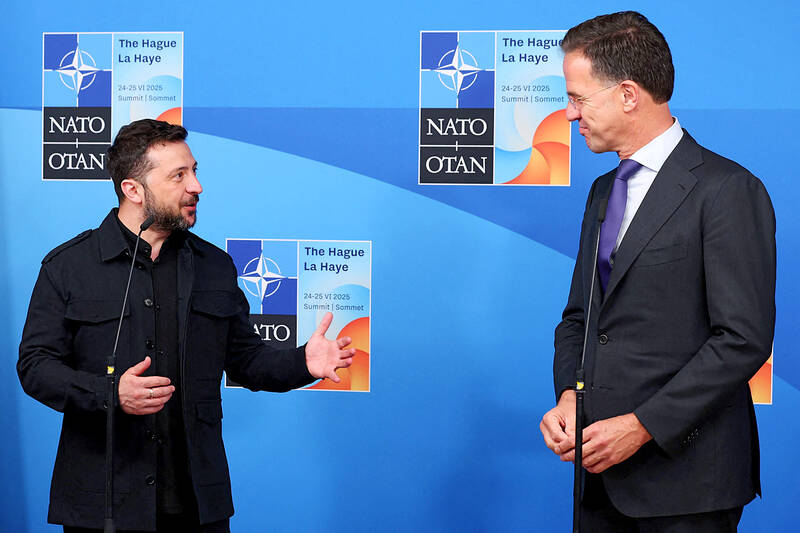By refusing to agree spending increases to appease US President Donald Trump, Spanish Prime Minister Pedro Sanchez threatened to derail a summit that NATO Secretary-General Mark Rutte needs to run smoothly for the sake of the military alliance’s future survival.
Ahead of yesterday’s gathering in The Hague, Netherlands, things were going off the rails. European officials have expressed irritation at the spoiler role that Sanchez is playing when their No. 1 task is to line up behind a pledge to raise defense spending to 5 percent of GDP. Rutte needed to keep Spain in line while preventing others such as Slovakia from breaking ranks.
Given that the entire summit has been designed around Trump, French President Emmanuel Macron did not help matters by saying that US and Israeli strikes on Iran lacked a legal basis. They are not comments that would be well-received by the US leader, who already snapped at Macron at the G7 summit.

Photo: AFP
The NATO leaders were meeting against the backdrop of heightened tensions in the Middle East. Trump yesterday declared a ceasefire between Iran and Israel, after a week that saw the US target Iranian nuclear sites and Iran retaliate with a telegraphed move on a US air base in Qatar.
Meanwhile, Russia’s invasion of Ukraine is well into its fourth year, with Russian President Vladimir Putin continuing to make hardline demands for territory.
As host, and making his own debut in the top job, it was shaping up to be a worst-case scenario for the Dutch secretary-general on his home soil. The risk is that Trump, who has already cottoned on to “notorious” Spain and has kept his trip short, sees the divisions spill out into the open and gets an excuse to walk out.
Rather than securing his iron-clad pledge to stand by the post-World War II alliance’s most sacrosanct principle of collective defense known as Article 5 (an attack on one is an attack on all), Spanish intransigence on spending could throw the optics into disarray.
“Spain thinks they can achieve those targets on a percentage of 2.1 percent” of GDP, Rutte told reporters on Monday. “NATO is absolutely convinced Spain will have to spend 3.5 percent to get there.”
Slovakian Prime Minister Robert Fico joined Spain in saying that his nation now would also reserve a right to decide how fast and by how much it increases its defense budget. Slovakia can meet the alliance’s requirements without hiking spending to the 5 percent level, he said.
All member nations have signed off on ambitious new lists of weapons and troops — so-called capability targets — that each needs to provide as part of its NATO commitment. The alliance has broken down the 5 percent goal to 3.5 percent spending on defense with an additional 1.5 percent dedicated to related investment.
“Each country will now regularly report what they are doing in terms of spending and reaching the targets,” Rutte said. “So we will see, and anyway there will be a review in 2029.”
Spain has refused to sign up to the 5 percent target, while also assuring NATO that it would fulfill the capability requirements. It is arguing that 2.1 percent of defense spending would be sufficient to achieve that.

Auckland rang in 2026 with a downtown fireworks display launched from New Zealand’s tallest structure, Sky Tower, making it the first major city to greet the new year at a celebration dampened by rain, while crowds in Taipei braved the elements to watch Taipei 101’s display. South Pacific countries are the first to bid farewell to 2025. Clocks struck midnight in Auckland, with a population of 1.7 million, 18 hours before the famous ball was to drop in New York’s Times Square. The five-minute display involved 3,500 fireworks launched from the 240m Sky Tower. Smaller community events were canceled across New Zealand’s

The Ministry of Foreign Affairs (MOFA) yesterday said it is closely monitoring developments in Venezuela, and would continue to cooperate with democratic allies and work together for regional and global security, stability, and prosperity. The remarks came after the US on Saturday launched a series of airstrikes in Venezuela and kidnapped Venezuelan President Nicolas Maduro, who was later flown to New York along with his wife. The pair face US charges related to drug trafficking and alleged cooperation with gangs designated as terrorist organizations. Maduro has denied the allegations. The ministry said that it is closely monitoring the political and economic situation

UNRELENTING: China attempted cyberattacks on Taiwan’s critical infrastructure 2.63 million times per day last year, up from 1.23 million in 2023, the NSB said China’s cyberarmy has long engaged in cyberattacks against Taiwan’s critical infrastructure, employing diverse and evolving tactics, the National Security Bureau (NSB) said yesterday, adding that cyberattacks on critical energy infrastructure last year increased 10-fold compared with the previous year. The NSB yesterday released a report titled Analysis on China’s Cyber Threats to Taiwan’s Critical Infrastructure in 2025, outlining the number of cyberattacks, major tactics and hacker groups. Taiwan’s national intelligence community identified a large number of cybersecurity incidents last year, the bureau said in a statement. China’s cyberarmy last year launched an average of 2.63 million intrusion attempts per day targeting Taiwan’s critical

‘SLICING METHOD’: In the event of a blockade, the China Coast Guard would intercept Taiwanese ships while its navy would seek to deter foreign intervention China’s military drills around Taiwan this week signaled potential strategies to cut the nation off from energy supplies and foreign military assistance, a US think tank report said. The Chinese People’s Liberation Army (PLA) conducted what it called “Justice Mission 2025” exercises from Monday to Tuesday in five maritime zones and airspace around Taiwan, calling them a warning to “Taiwanese independence” forces. In a report released on Wednesday, the Institute for the Study of War said the exercises effectively simulated blocking shipping routes to major port cities, including Kaohsiung, Keelung and Hualien. Taiwan would be highly vulnerable under such a blockade, because it